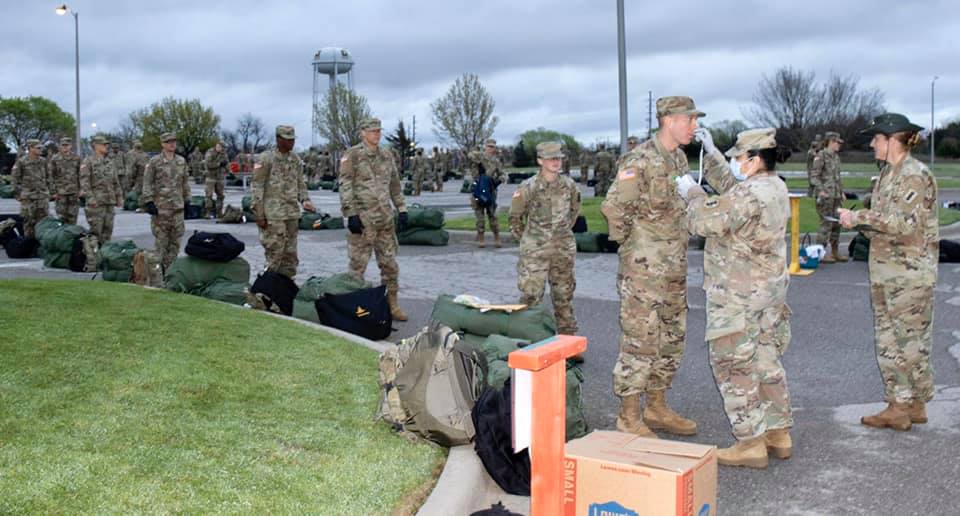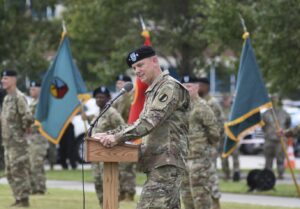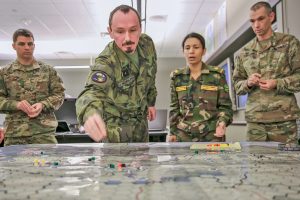
Army soldiers undergo COVID-19 coronavirus checks at Fort Sill, Okla.
WASHINGTON: This morning, hundreds of new recruits began arriving at the Army’s four initial training centers, the first in two weeks. While training had continued for soldiers already in the pipeline, the hold on new arrivals gave Training & Doctrine Command time to shore up its defense against the COVID-19 coronavirus. That included stocking enough test kits and diagnostic systems for the 950 recruits coming in this week, as well as their instructors.

Gen. Paul Funk
“We have enough test kits [and] testing equipment,” the four-star TRADOC commander, Gen. Paul Funk, said on a conference call this afternoon. “We just got the equipment, we just got the tests.”
“We had enough to do symptomatic people [only] before,” Funk told reporters. “Now we can do everyone” in initial training. That includes the young incoming trainees – who’ll live on base in a “bubble” to limit contagion – and their older instructors – who mostly live off-base and must come in and out, which means they’ll have to wear masks and undergo unspecified “decontamination” procedures.
Before the two-week pause, there were only enough kits and diagnostic equipment available to check people with presumptive COVID symptoms (primarily elevated temperature, a dry cough, and fatigue) and those in immediate contact with them. That is how the Army discovered its largest cluster of cases, a group of about 50 trainees in a single battalion at Fort Jackson, SC, which trains roughly half of all incoming Army recruits. Most of those 50 showed no symptoms but were potentially contagious, as seems to be the case for the vast majority of COVID-19 coronavirus infections worldwide. That’s why public health experts say widespread, repeated testing is essential.
That said, testing by itself isn’t the solution, either. TRADOC has instituted a multi-step process:
- 14 days before officially joining up, prospective recruits must isolate themselves at home, with their recruiter checking in regularly by phone.
- If the future soldier remains asymptomatic, they get to go to a Military Entry Processing Station (MEPS), where they’re checked out in person.
- Then they’re put on a carefully disinfected bus to one of the Army’s four initial training centers: Fort Benning, Ga. specializes in tank crews, scouts, and infantry; Fort Sill, Okla. specializes in artillery, from howitzers to long-range missiles to Patriots; while Fort Jackson and Fort Leonard Wood, Mo. handle everybody else.
- On arrival, they’re kept under “controlled monitoring” for their first 14 days on base, isolated in platoon-sized groups to contain any contagion. They train during this time, but it’s mostly individual physical training and classroom instruction – held outside where possible – with everyone at least six feet apart. Subject matter is such basics of basic training as recognizing rank insignia, proper saluting and marching, ethical conduct and so on, classes that would normally be woven throughout the training program but which are now concentrated in the first two weeks.
- After 14 days, if the new soldiers are still healthy, they get to start field exercises and other hands-on training. This phase will last eight weeks for most troops (who then go on to myriad specialized technical courses), longer for infantry recruits and other combat-arms soldiers (who go directly to operational units).
This whole initial training process is just the bottom of the pyramid that is the Army’s continuing education system. While initial training has enough test equipment, TRADOC is still expanding testing to more advanced schools.
“We have adequate testing capability at all of our [initial] training centers now and we’re continuing across the TRADOC enterprise,” Gen. Funk said. “By the end of the month, we should have all of our systems in place.”

US and allied officers play a tabletop wargame at the Command & General Staff College, Fort Leavenworth, KS, in the pre-COVID-19 era.
In the meantime, there are stopgaps. Airborne School, for example, is located at Fort Benning, alongside initial training for infantry and armor soldiers. Normally officers and NCOs from across the Army come for the prestigious parachute course, considered a major plus for promotion. But TRADOC staff told me the current Airborne class, about 350 strong, is entirely composed of junior personnel who were already on Fort Benning and had just completed their initial training.
What about the tens of thousands of mid-career soldiers who are in Professional Military Education (PME) courses across the country? There are courses for every specialty and almost every rank, with successful completion often a prerequisite for further promotion. While many of those courses have a distance learning element, soldiers usually have to travel from their current unit to a training center like the Army War College or the Sergeant Majors’ Academy, and non-essential travel is currently banned through at least June 30th.
That’s caused considerable anxiety across the ranks. Lt. Gen. James Rainey, commander of Fort Leavenworth – home of the Command & General Staff College – told reporters on today’s call that many of those requirements have been temporarily waived: Non-commissioned and commissioned officers can get their promotions and new assignments without the normal required courses, although they’ll have to catch up at some future point.
The big test for TRADOC, however, will be how it handles the summer surge of new recruits. The number of young soldiers entering basic training rises and falls on a regular cycle throughout the year, and the annual peak comes soon after high school graduations. That’s long before any coronavirus vaccine will be available – and it’s an open question whether the US will have the pandemic under control.
‘AI-BOM’ bombs: Army backs off, will demand less detailed data from AI vendors
Instead of demanding an exhaustive “AI Bill of Materials.” the Army will only ask contractors for a “baseball card” of key stats on their AI — while building up its in-house capacity to check for bad code or “poisoned” data.



























